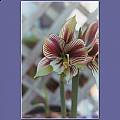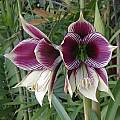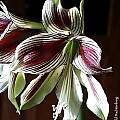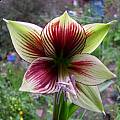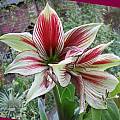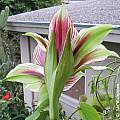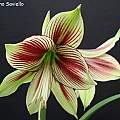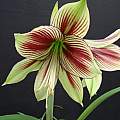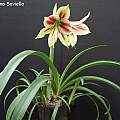Hippeastrum papilio (Ravenna) Van Scheepen is an endangered epiphytic species within subgenus Omphalissa that, paradoxically, is increasingly propagated among gardeners while its natural range is degraded and diminished. It is native to tropical forests of the Atlantic Coast of southern Brazil.
In 1967, H. papilio was discovered in a garden in Santa Catarina state, southern Brazil, by Dr. Carlos A. Gómez Rupple, an Argentine collector. The species was published as Amaryllis papilio by Argentine botanist Pedro Félix Ravenna (Pierfelice Ravenna) in 1970, after a genus Papilio of swallowtail butterflies due to the resemblance of the inner tepals to the wing tails of the insects (hence, the common name of 'Butterfly Amaryllis'). In 1997, Van Scheepen separated New World amaryllids (Amaryllidaceae) from African true Amaryllis and assigned the genus name Hippeastrum to the American species. Hippeastrum papilio was considered extinct in its natural habitat until the 1990s, when an Escondido, California plant breeder, Fred Meyer, observed it growing in tall trees in the southern Brazilian state of Rio Grande do Sul.
Hippeastrum papilio survives now as a population of approximately 50 plants within a 4-square-mile patch of Atlantic Forest habitat, fragmented by roads and drains. These survivors are representatives of larger species and genus distribution. The forest's original 476,000 square miles was reduced to only 38,600 square miles, first by sugarcane and coffee plantations and later by urbanization. The original forest was about the size of Texas, Louisiana, Mississippi, Alabama and Florida combined. The remaining forest is smaller than Mississippi.
This species is quite constant in terms of the shape of its tepals, although the degree of lateral compression does vary. On the other hand the color can vary from white through a creamy-green, to a quite dark apple-green with carmine, maroon or purple striations. Among the 80+ known Hippeastrum species, many cultivated species can each be traced to only a few plants that were collected and propagated. Thus, commercial Hippeastrum producers risk loss to diseases, because only about 10% of Hippeastrum genomic diversity is present in existing cultivars. Hippeastrum papilio is an evergreen that does not display any symptoms of infection by Hippeastrum Mosaic Virus (HMV). Thus far, its hybrid offspring express a wide range of levels of resistance to mosaic virus. Some bulbs of H. papilio are self fertile, and some are self sterile. Len Doran suggested that the species was of natural hybrid origin and does breed true within the parameters of a species description. Some forms are green flowered with the dark red markings and others are white with red or very dark marking. In any case, it is a wonderful very easy plant to grow in pots or in the garden. It can even take some mild frost on the leaves in winter.
In Brazil, H. papilio blooms in October, the southern hemisphere spring, but in cultivation in the United States and Europe, H. papilio may bloom at any time in late winter to early spring. The flowers will readily set seeds, but will not self-pollinate. The plant also multiplies by producing off-shoots of bulbs. It is among the most vigorous of the Hippeastrum species, with rapidly growing seedlings, making it an excellent parent for hybrids. However, some cross-pollination with existing hybrids produces seeds that grow vigorously at first, but abort after 28 days due to chromosome incompatibility.
Photos below were taken by Jennifer Hildebrand in February 2003, Doug Westfall in March 2003, and Arnold Trachtenberg.
Photos 1-3 were taken by Liz Waterman grown from a bulb obtained through BX 3, Aug. 2002 from Cathy Craig. It started to open New Year's eve, and on New Year's day it was fully open and a 2nd bloom was beginning to show. In photo 3, the lower left background is a clump of Bomarea flowers. Photos 4-6 were taken by Mariano Saviello of plants grown in his greenhouse.
